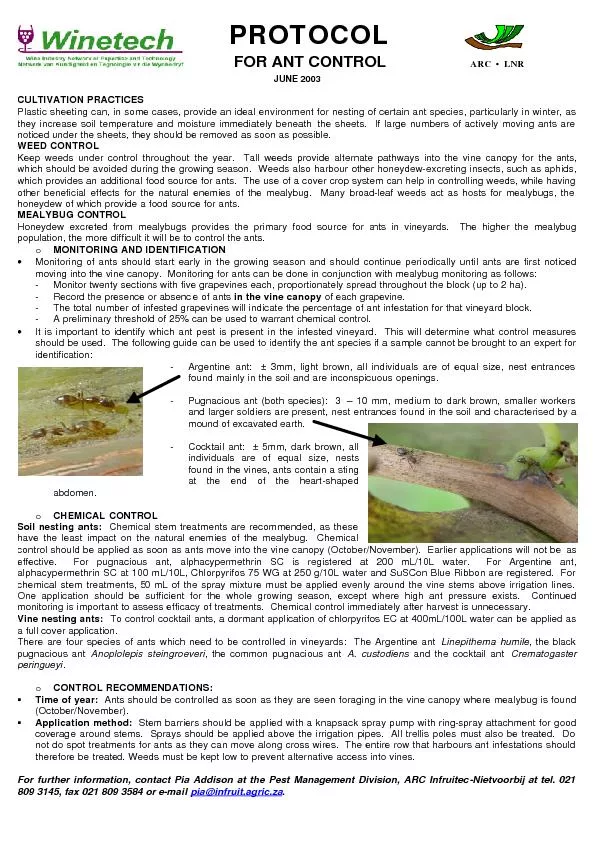/


PROTOCOL CULTIVATION PRACTICES Plastic sheeting can in some cases provide an ideal environment for nesting of certain ant species particularly in winter as they increase soil temperature and ID: 405966
Download Pdf The PPT/PDF document "FOR ANT CONTROL" is the property of its rightful owner. Permission is granted to download and print the materials on this web site for personal, non-commercial use only, and to display it on your personal computer provided you do not modify the materials and that you retain all copyright notices contained in the materials. By downloading content from our website, you accept the terms of this agreement.
PROTOCOL FOR ANT CONTROL CULTIVATION PRACTICES Plastic sheeting can, in some cases, provide an ideal environment for nesting of certain ant species, particularly in winter, as they increase soil temperature and moisture immediately beneath the sheets. If large numbers of actively moving ants are noticed under the sheets, they should be removed as soon as possible. WEED CONTROL Keep weeds under control throughout the year. Tall weeds provide alternate pathways into the vine canopy for the a nts, which should be avoided during the growing season. Weeds also harbour other honeydew - excreting insects, such as aphids, which provides an additional food source for ants. The use of a cover crop system can help in controlling weeds, while having er beneficial effects for the natural enemies of the mealybug. Many broad- leaf weeds act as hosts for mealybugs, the honeydew of which provide a food source for ants. MEALYBUG CONTROL Honeydew excreted from mealybugs provides the primary food source for a nts in vineyards. The higher the mealybug population, the more difficult it will be to control the ants. o MONITORING AND IDENTIFICATION · Monitoring of ants should start early in the growing season and should continue periodically until ants are first notice d moving into the vine canopy. Monitoring for ants can be done in conjunction with mealybug monitoring as follows: - Monitor twenty sections with five grapevines each, proportionately spread throughout the block (up to 2 ha). - Record the presence or absence of ants in the vine canopy of each grapevine. - The total number of infested grapevines will indicate the percentage of ant infestation for that vineyard block. - A preliminary threshold of 25% can be used to warrant chemical control. · It is important to ide ntify which ant pest is present in the infested vineyard. This will determine what control measures should be used. The following guide can be used to identify the ant species if a sample cannot be brought to an expert for identification: - Argentine ant: ± 3mm, light brown, all individuals are of equal size, nest entrances found mainly in the soil and are inconspicuous openings. - Pugnacious ant (both species): 3 – 10 mm, medium to dark brown, smaller workers and larger soldiers are present, nest entra nces found in the soil and characterised by a mound of excavated earth. - Cocktail ant: ± 5mm, dark brown, all individuals are of equal size, nests found in the vines, ants contain a sting at the end of the heart-shaped abdomen. o CHEMICAL CONTROL Soil nest ing ants: Chemical stem treatments are recommended, as these have the least impact on the natural enemies of the mealybug. Chemical control should be applied as soon as ants move into the vine canopy (October/November). Earlier applications will not be as effective. For pugnacious ant, alphacypermethrin SC is registered at 200 mL/10L water. For Argentine ant, alphacypermethrin SC at 100 mL/10L, Chlorpyrifos 75 WG at 250 g/10L water and SuSCon Blue Ribbon are registered. For chemical stem treatments, 5 0 mL of the spray mixture must be applied evenly around the vine stems above irrigation lines. One application should be sufficient for the whole growing season, except where high ant pressure exists. Continued monitoring is important to assess efficacy of treatments. Chemical control immediately after harvest is unnecessary. Vine nesting ants: To control cocktail ants, a dormant application of chlorpyrifos EC at 400mL/100L water can be applied as a full cover application. There are four species of ants which need to be controlled in vineyards: The Argentine ant Linepithema humile , the black pugnacious ant Anoplolepis steingroeveri, the common pugnacious ant A. custodiens and the cocktail ant Crematogaster peringueyi . o CONTROL RECOMMENDATIONS: § Time of year: Ants should be controlled as soon as they are seen foraging in the vine canopy where mealybug is found (October/November). § Application method: Stem barriers should be applied with a knapsack spray pump with ring- spray attachment for good e around stems. Sprays should be applied above the irrigation pipes. All trellis poles must also be treated. Do not do spot treatments for ants as they can move along cross wires. The entire row that harbours ant infestations should therefore be treated. Weeds must be kept low to prevent alternative access into vines. For further information, contact Pia Addison at the Pest Management Division, ARC Infruitec - Nietvoorbij at tel. 021 809 3145, fax 021 809 3584 or e -mail pia@infruit.agric.za ARC • LNR JUNE 2003